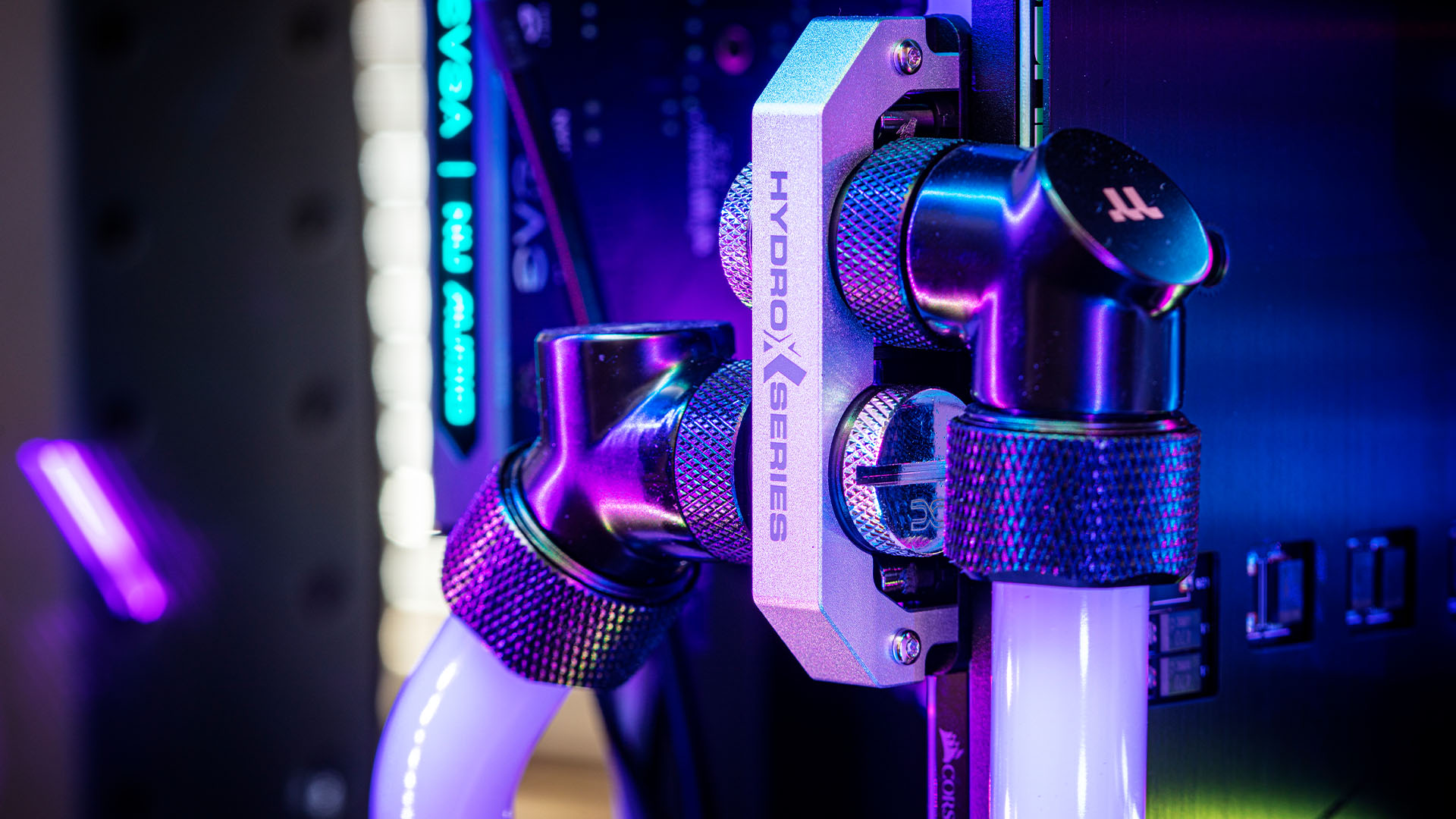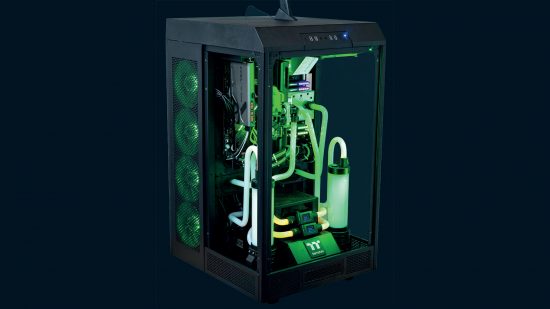If you think a 360mm AIO liquid cooler has loads of cooling power, then wait until you see the monstrous cooling abilities of this water-cooled Threadripper gaming PC build. This monster Threadripper PC, which owner Sam Liggat calls The Silent Storm, features loads of freehand tubing bends across two loops, attached to two colossal 560mm radiators.
Thanks to our rapidly growing PC building Facebook page, we’ve seen many custom gaming PCs, from mods based on existing case designs to scratch PC builds. You can even submit yours for consideration right here. Now let’s chat to Sam about how he made this hard tube water-cooled PC build.
PCGamesN: What inspired you to build this PC, and why did you choose to build it in the Thermaltake Tower 900 chassis?
Sam: It all started when I ran out of fast storage on my old rig. We have a painfully slow internet connection at my workshop, so I found myself having to delete old programs and games whenever I had to install something new. I picked up an Asus PCIe NVMe expansion card, but my old motherboard didn’t support lane bifurcation, so only one drive was accessible.
I’d been feeling the itch to build a new PC for a while anyway, so this was the perfect excuse. The Threadripper was the ideal choice, due to the colossal number of PCIe lanes, allowing me to run multiple NVMe drives alongside a fast graphics card, EVGA sound card, and Vive wireless card.

In all honesty, the CPU isn’t used to its full capacity. I do some video transcoding for YouTube and a fair bit of CAD modeling for 3D printing, but most of the time only four or five cores are in use. The real benefit comes from all those PCIe lanes.
Once I’d settled on Threadripper, I knew that noise was going to be the biggest concern. I like quiet PCs, but I’m not willing to sacrifice performance for low-noise operation – there had to be a way to achieve both.
This led directly to the motherboard choice, as the additional power handling allows it to run much cooler than other options, and the choice to use enormous 560mm radiators with the Thermaltake Tower 900 case – it was the only case that could handle multiple 560mm rads as standard.
Those tight bends and turns in the tubing look like a lot of work – why did you choose to go with this method rather than using angled fittings and straight tubing?
I took my inspiration there from the existing builds I’d seen in Tower 900 cases. I really liked some of the designs, but I thought a more complex, fluid-pipe setup would contrast well with the strong, simple geometric shape of the case. I work with miniature gearboxes for airsoft guns every day, which can be very fiddly and frustrating, so I felt I was up for the challenge.
How did you go about measuring, cutting and bending the tubing?
This was my first hardline water-cooling loop. To avoid unnecessary frustration and minimize compatibility issues, I tried to stick with one brand as much as possible. I went with Thermaltake PETG 16mm tubing, and used the Thermaltake tube-cutting tool kit for most of the tube work. I measured using paracord and a tape measure, and I also mocked up each run after each bend.

That’s an enormous amount of cooling power. Why did you use two loops with 560mm radiators?
Ha, yeah, it turned out to be a lot more complex than I initially imagined! I chose the 560mm radiators, so I could use ultra-quiet fans but still adequately cool the beastly processor. I then went for two loops, as I didn’t want the CPU to be dumping excess heat into the GPU cooler, or the other way around.
The Bio-Loop PWM fans (all 13 of them) are barely audible when running at 11 percent speed, but the system is still able to keep the CPU at 55°C or cooler under light load, and under 70°C under full load, while the graphics card has yet to breach 46°C under full load. There’s plenty of room for overclocking too. The CPU is currently running at stock speed for the most part, but the graphics card has an additional 11 percent overclock above the Asus Strix factory overclock.
Separating the two loops also allows for easier expansion, so I can upgrade the graphics card when something new comes calling. The left loop is connected to the CPU/motherboard monoblock and then back to the right-side radiator. The right loop cools the graphics card and is connected to the left-side radiator. Both loops cross at the front and then again at the back.
I also knew I wanted to have the two coolant temperature monitors at the front, to occupy that dead space and hide all the cables inside the central column, so the loop designs were loosely planned around them.
How useful are the temperature monitors?
They’re definitely not essential – they were more of an aesthetic choice, with the bonus of letting you easily monitor the coolant temps. They monitor the coolant as it leaves the reservoir and, at that point, even under full load when stress testing, the coolant temperature rarely exceeds 35°C.

Where did you get those PSU cables, and how did you plan the cable routing?
The Asus motherboard came with a 20 percent off coupon for CableMod US, so that’s where I bought the cables. The PSU comes with long cables, but they weren’t long enough for this case, so I knew I was always going to need longer ones. Cable routing is a guilty pleasure of mine, so it was pretty straightforward and there’s heaps of space to keep them neat and in line. There are a few hidden cable ties between some of the bundles to keep them in position.
How did you plan the lighting?
Lighting was a bit of an afterthought in terms of planning. Initially, I planned to keep it very simple, with just some white lights here and there, but my six-year-old daughter convinced me otherwise.
I picked up some Asus aRGB strips and Thermaltake RGB fittings for the tubing, but I wasn’t sure where they would go until I started. The aRGB strips sit nicely in the front inside edges of the case, and aren’t visible from most angles. The RGB fittings went wherever I could neatly hide their power cables.
Did you perform any custom case modifications?
There weren’t many modifications required. I made a cutout in the motherboard tray, so I could run the rear-mounted NVMe drive with a heatsink. I cut it out with a Foredom rotary tool and finished it off with a hand file and some silicon carbide lapping paper, using with a light silicon oil to prevent the grit from clogging.
Did you come across any difficulties?
The biggest pain was mounting the fans and radiators on the mounts. The fans come with their own zero-vibration mounting kit, but their screws weren’t thick enough to bite into the radiator threads. Meanwhile, the screws that came with the rads weren’t long enough to go through both sides of the fans but were too long to go through just one side. I ended up having to cut down and finish 32 screws by hand just to mount the fans and rads.
The other main difficulty was getting those coolant monitors level and spaced apart correctly. They’re only supported by the tubing – a freehand spiral that was the most complex part of the build. In order to get them sitting (almost) perfectly, I had to mount all the water-cooling gear in place with the support rod fully inside the tube, and heat the tube in situ while holding it still as it cooled. I had to do the same with the tube going to the GPU – the right tube has four bends and the left one has five.

Are you happy with the end result, or do you wish you’d done some of it differently in retrospect?
I’m around 98% happy with this build. It’s the dream machine I’ve fantasized about for years, but there are a couple of little imperfections. One or two of the bends aren’t quite perfect, but I can correct them when I next drain the system.
I’ll build in a couple of air-bleed ports as well – there are two air bubbles that I simply can’t flush out due to the complexity of the loops. The weight of the system (almost 50kg) precludes tilting it to work them out, but a couple of valves at the top will sort that problem.
Silent Storm water-cooled PC specs
- CPU: AMD Threadripper 3960X
- Case: Thermaltake Tower 900
- Graphics card: Asus ROG Strix GeForce RTX 2080 Ti OC
- Storage: 1TB Corsair PCIe 4 SSD for OS; 2 x 1TB Samsung 970 Pro NVMe SSDs
- Memory: 64GB Corsair Dominator Platinum RGB 3400MHz (tweaked for tighter timings)
- Motherboard: Asus Zenith II Extreme Alpha TRX40
- PSU: Corsair AX1600i Titanium
- Cooling: Dual custom water-cooling loop comprising: 2 x Thermaltake PR22-D5 Silent pump/reservoir combos, 2 x Thermaltake in-line temp monitors, 3 x Thermaltake Pacific Pro 90-degree fittings, 1 x Thermaltake Pro 45-degree fitting, 20 x Thermaltake Pacific Pro compression fittings, EK-Quantum Momentum monoblock for Asus Zenith II Extreme Alpha motherboard, Corsair Hydro waterblock for Asus RTX 2080 Ti Strix with Thermal Grizzly thermal pads, 5m of Thermaltake PETG hardline tubing, 2 x EK-Coolstream 560mm radiators, 2 x EK 3-way fittings (modified to work with the Thermaltake Pro fittings), 2 x Thermaltake Pro ceramic drain ports, 4 liters of Thermaltake Pastel White coolant, 1 x Thermaltake RGB fitting kit, 13 x Black Silence Noiseblocker eLoop aRGB PWM 140mm fans
We’re gobsmacked by the cooling power in this machine Sam – it makes the average 240mm AIO cooler in our best AIO cooler guide look positively weedy. Well done on the bends in your hardline water-cooling tubing too – it looks great. If you’re new to the world of water-cooling and want to have go yourself, then make sure you also read our full guide on how to water-cool your PC.
This post originally appeared on Custom PC, which has been covering amazing setups for over 20 years and is now part of PCGamesN. Join our 500k member Facebook group to discuss this build.
If you consider yourself to be an expert PC builder, you can submit your own custom PC build to us today for a chance of being featured on PCGamesN in the future.
